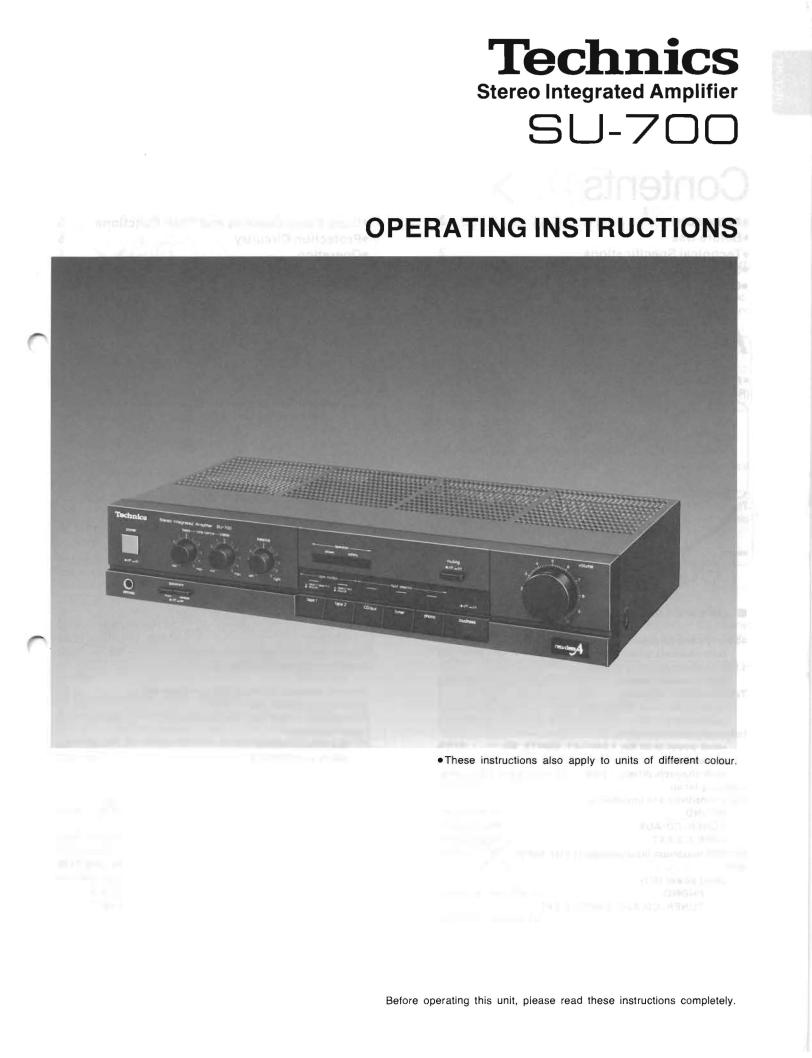TECHNICS SU-700 User Manual


I |
We want to thank you for selecting this product and |
||||
to welcome you to the growing family of satisfied |
|||||
Technics product owners around the world. |
|
||||
We feeI certain you wil! |
get maximum enjoyment |
||||
|
|
|
|
|
|
|
Contents |
|
|||
|
.Accessory ... . . . . . . . . |
. . . . . . . . |
. . . . . . . . . . . .. |
2 |
|
|
.Before Use ................... |
, ............ |
2 |
||
|
.Technical Specifications .................. |
2 |
|||
|
.Suggestions for Safety |
.................... |
|
3 |
|
|
.Connections .. . . . . . . . |
. . . . . . . . |
. . . . . . . . . . . .. |
4 |
|
from this new addition to your home.
Please read these operating instructions carefully, and be sure to keep them handy for convenient reference.
.Front Panel Controls and Their Functions |
.. |
5 |
.Protection Circuitry ........................ |
|
5 |
.Operation ................................ |
|
6 |
.Troubleshooting Guide ................. |
.. |
7 |
.Maintenance .............................. |
|
7 |
Accessory
• AC power supply cord ............ |
1 |
(Reter to page 4.) |
|
The configuration ol the AC outlet and AC power supply cord differs according to area.
Before Use
Be sure to disconnect the mains cord belore adjusting the voltage selector.
Use a minus (-) screwdriver to set the voltage selector (on the rear panel) to the vollage setting lor the area in which the unit wil! be used.
(It Ihe power supply in your area is 117 V or 120 V, set to the "127 V" position.)
Note that this unit wil! be seriously damaged il this setting is not made correctly. (There is no voltage selector lor some countries; the correct voltage is already set.)
Technical Specifications (DIN 45500)
•AMPLIFIER SECTION
40 Hz-20 kHz continuous power output both channels driven
1 kHz continuous power output both channels driven
Total harmonie distortion
rated power at 40 Hz-20 kHz half power at 1 kHz
Intermodulation distortion
rated power at 60 Hz: 7 kHz=4:1, SMPTE, 80 Power bandwidth
both channels driven, -3 dB Damping factor
Input sensitivity and impedance PHONO
TUNER, CO/AUX TAPE 1, 2/EXT
PHONO maximum input voltage (1 kHz, RMS) SIN
rated power (80)
PHONO 71 dB (IHF. A: 72 dB) TUNER, CO/AUX, TAPE 1,2/EXT
90 dB (IHF. A: 98 dB)
Frequency response |
|
PHONO |
RIAA standard curve |
|
±0.8 dB (30 Hz-15 kHz) |
TUNER, CO/AUX, TAPE 1,2/EXT |
5 Hz-90 kHz (-3 dB) |
Tone controls |
|
|
|
BASS |
|
50 Hz. +10 dB~-10 dB |
|
TREBLE |
|
20 kHz. \-10 dB~-10 dB |
|
Loudness control (volume at -30 dB) |
|
50 Hz. +9 dB |
|
Output voltage and impedance |
|
|
|
REC OUT |
|
|
150 mV |
Channel balance, CO/AUX 250 Hz-6,300 Hz |
:::1 dB |
||
Channel separation, AUX 1 kHz |
|
45 dB |
|
Headphones output level and impedance |
560 mV/3300 |
||
Load impedance |
|
|
|
MAIN or REMOTE |
|
|
|
MAIN and REMOTE |
|
|
|
• GENERAL |
|
|
|
Power consumption |
|
|
360W |
Power supply |
|
|
|
For Australia |
|
AC 50 Hz/60 Hz. 240V |
|
For continental Europe |
AC 50 Hz/60 Hz. 220V |
||
For others |
AC 50 Hz/60 Hz. 11 OV/127V/220V/240V |
||
Oimensions (WXHXO) |
|
430 X 86 X 240 mm |
|
|
(16-15/16" X 3-3/8" X 9-7/16") |
||
Weight |
|
|
5.3 kg (11.7 lb.) |
Note:
Total harmonie disloriion is measured by Ihe digital spectrum analyzer (H.P. 3045 system).
- 2

Suggestions for Safety
• Use a standard electrical AC wall outlet
1.Use trom an AC power souree ot high voltage, sueh as tor air eonditioners, is very dangerous.
Be exlremely carelul nol 10 make aconnection 10 the electrical outlet lor a large air conditioner or central-heating unit which uses high voltage, because there is the possibility ol fire.
2.A DC power souree eannot be used.
Be sure 10 check the power source carefully, especially on a ship or olher place where DC is used.
• If water is spilled on the unit
Be extremely careful if water is spilied on the unit, because a fire or serious electric shock might occur. Immediately disconneet the power cord plug, and consult wilh your dealer.
-• Connectionplug and removal of the power cord
1.Wet hands are dangerous.
A dangerous electric shock may result if Ihe plug is touched by wet hands.
2.Don't pull the power eord.
Always grasp the plug; never pull Ihe cord itself.
x
•Never attempt to repair or reconstruct this unit
A serious eleclric shock might occur if Ihis unit is repaired, disassembied or reconstructed by unauthorized persons, or if Ihe internal parls are accidently touched.
- x
• For families with children
Never permit children 10 put anything, especially metal, inside th is unit. A serious electric shock or malfunclion could occur il articles such as coins, needies, screwdrivers, elc. are inserled through the ventilation holes, etc. ol Ihis unit.
x 
• Turn off after use
II the unit is left lor a long lime with the power on, this will not only shorten its useful operation life. but mayalso cause other unexpected trouble.
x 
•Place the unit where it will be weil ventilated, and away from direct sunlighf
Place th is unit at least 10 cm (4") away from wall surfaces, elc., and away from direct sunlight. Be careful that curtains and similar materials do not obstruct the ventilation holes.
x 
• Keep the unit away from heaters, etc.
Heat can damage the external surfaces as weil as internal circuits and components.
• Avoid spray-type insecticides
Insecticides might cause cracks or "cloudiness" in the cabinet and plastic parts ol this unit. The gas used in such sprays might, moreover, be ignited suddenly.
[x~ ]
• Never use alcohol or paint thinner
These and similar chemicals should never be used, because they may damage the finish.
[~x_~__·,~~~_.~~~]
• If trouble occurs
If, during operation, the sound is interrupted or indicators no longer illuminate, or if abnormal odor or smoke is detected, immediately disconneet the power cord plug, and contact your dealer or an Authorized Service Center.
-3

Connections
HTUNER" terminals
Connect a tuner.
"CDtAUX" terminals |
"TAPE 1n terminals |
Use these terminals to connect a |
Connect an audio tape deck. |
compact disc player (digital audio disc), |
|
or tape deck (playback only). |
|
Tuner (option) |
Compact disc player (option) |
Tape |
deck 1 (option) |
OUTPUT |
lINEQl1T |
LlNE IN |
UNE OUT |
|
|
||
|
|
|
ff
(R) (L)
Stereo connection
"PNDNDH terminals |
|
- |
Connect a turntabie. |
|
|
Turntable |
(option) |
|
|
i |
|
(GND) |
(GND) |
|
Stereo connection ~"-->-I |
l,~ |
|
cable (option) |
|
Ground wire (option) |
Speaker connection cord (option)
"TAPE 2IEXT" terminals |
Stereo connectio |
|
Connect a second tape deck or a graphic |
cable (option) |
|
|
||
equalizer. |
|
|
Tape |
deck 2 (option) |
|
UNE IN |
UNI: OUT |
|
Speaker terminals ("SPEAKERS")
• Connection of speaker wires
<D Strip oft the outer covering, and |
CD == |
||
|
twist the center conductor. |
|
15 mm (19/32") |
® Turn completely to the left. |
|
|
|
@ Insert wire and turn completely |
(]) |
|
|
|
to the right. |
|
|
|
Pull wire to insure a proper |
|
|
|
connection. |
|
|
|
|
|
|
|
Nole: |
|
|
|
|
|
|
|
|
|
|
|
To prevent damage 10 circuitry, |
|
|
|
never short-circuit plus (+) and |
|
|
|
minus (-) speaker terminals. |
|
|
|
|
|
|
'--------------------------------------- |
~ |
||
• Remote speaker terminals ("REMOTE")
For connection 10 a second pair of speakers.
•• |
(-)(+) |
(-)(+) |
|
|
~~ |
(right) |
Oeft) |
Main speaker systems (option)
Household
AC outlet -
The configuration of the AC outlet and AC power supply cord differs according to area.
Speaker impedance selector
Set to the position corresponding to the impedance of the speaker systems being used.
If a speaker system with an impedance value outside these ranges is connected, low output, protection circuit aclivation or amplifier damage may occur.
• 11 either the main or the remote speaker systems are used:
4~611 (........ ):
For speaker impedance of 4~611. 8~1611(........):
For speaker impedance of a~1611.
•11 both main and remote speaker systems are used:
1)If the impedance of both systems is 16 ohms, set the speaker impedance selector to "16n".
2)If the impedance of both systems is a ohms, or one is aohms and the other is 16 ohms, set the speaker impedance seleclor
to "a11".
Note:
Be sure 10 make this setting before swilching Ihe power "on".
- 4

|
Front Panel Controls and Their |
I |
|||||
|
Functions |
|
|
put selectors (input selector) |
|||
|
|
.Pn\l\,~r switch/indicator (power) __ |
|
|
|
||
|
|
|
|
|
|||
|
|
At the "on" position, the indicator wil! illuminate to indicate ~ |
|
These selectors are used to select the sound souree 10 be |
|
||
|
|
that the power is on. Before turning the power on. make |
I |
|
heard, such as a disc, radio broadcasl, etc. The correspondlng |
|
|
|
|
sure the volume conlrol is set to the low position. |
I |
|
indicator illuminales during operalion 10 indicate the selecled |
|
|
|
|
|
I |
|
sound souree. |
|
|
|
|
|
|
|
io muting switch |
|
|
|
|
Safety operation indicator .------;I--....... |
|
|
|
||
|
|
|
|
(muting) |
|
||
|
|
(operation) |
|
|
|
|
|
|
|
|
|
|
Set to Ihe "on" posilion when a |
|
|
|
|
This indicator illuminates after the power is |
|
|
|
|
|
|
|
|
|
|
dlsc is being changed or to |
|
|
|
|
switched on and the unit IS in the operation |
|
|
|
|
|
|
|
|
|
|
temporarily reduce Ihe volume |
|
|
|
|
condition. If the unit detects an abnormal |
|
|
|
|
|
|
|
|
|
|
level. |
|
|
|
|
condition in the circuitry, such as a DC |
|
|
|
|
|
|
|
|
|
|
In addition, Ihe volume level |
|
|
|
|
component in the output, etc., or if the posilive |
|
|
|
|
|
|
|
|
|
|
can be adjusled more precisely |
|
|
- |
|
(+) and negalive (- ) connection wi res from the |
|
|
|
|
|
|
|
|
|
if th is switch is set to the "on" |
|
||
|
speaker terminals are short-circuited. Ihe |
|
|
|
|
||
|
|
|
|
position lor listening at a low |
|
||
|
prolection circuilry will luncllon 10 slop Ihe unit's |
|
|
|
|
||
|
|
|
|
volume level. |
|
||
|
operation and thls indicator will no longer |
|
|
|
|
||
|
|
|
|
|
|
||
|
|
illuminate. II this occurs, switch olf the power, and |
|
|
|
Volume control (volume) |
|
|
|
then, after finding and correcting the cause ol the |
|
|
|
|
|
|
|
problem. switch the power switch on once again. |
|
|
|
|
|
Balance control
|
(balance) |
|
Set to the "on" position when listening to music at low volume. |
|
|
|
Auditory perceplion of sound in Ihe low Irequency range falls |
|
Tone controls (bass/treble) |
|
oft al low volume, but when Ihe switch is in Ihis posilion, this |
|
|
deficiency is compensated for, so thai Ihe tuil impact of the |
|
|
|||
|
|
|
musical performance can be enjoyed. |
peaker selectors (speakers) |
|
ape-monitor selectors (tape monitor) |
|
|
|||
These selectors are used lolurn Ihe speaker syslems on and off.
Headphones jack (phones)
Note:
Be sure to set Ihe volume level to the minimum ("0") position belore connecting the headphones.
souree (.a...,. I):
Set to this position 10 lislen la a phono disc or radio broadcast, or 10
listen to equipmenl connected 10 the auxiliary-input terminals ("CDAUX'') tape 1/tape 1 ~2 (I--.a), tape 2/ext (I-..a):
Set to this position to playback or monitor Ihe sound from a tape deck. The indicators above the tape-monitor selector illuminate la
indicale tape 1 or tape 2. tape 1 ~2:
Tape recordings from tape deck 1 10 tape deck 2 can be made by pressing the left switch inward to the "tape 1" position, releasing the right switch outward to the "souree" position, and by preparing tape deck 1 for playback and tape deck 2 for recording.
Nole that recordings cannol be made from lape deck 2 10 tape deck 1.
Protection Circuitry
The protection circuilry may have operaled if eilher of the
following conditions |
is noliced: |
-No sound is heard |
when the power is turned on. |
-Sound stops during a performance.
The funclion of this circuitry is to prevent circuilry damage if, for example, the positive and negative speaker connection wires are "shorted", or il speaker systems with an impedance less than the indicated rated impedance ol the amplifier are used.
If th is occurs, follow the procedure outlined below:
1.Turn olf the power.
2.Determine Ihe cause of the problem and correct it
3.Turn on the power once again.
Note:
When Ihe pralection circuilry functions, Ihe unit will not operate unless the power is lirsl turned olf and then on again.
5

 Operation
Operation
Power: "on" (.~....)
1Before turning the power on, make sure the volume control is set to the low position.
2 Select speaker systems to be used.
3 To listen to tape set to the "tape 1/tape 1"'2" or "tape 2/ext" :
If bath tape-monitor selectors are pressed at the same time, only the sound Irom tape deck 2 will be heard.
-
6 Adjust the volume
Adjust tone quality as desired. Low-range sound is adjusted with bass control ("bass"), and high-range sound with treble control ("treble").
|
|
Set to the "on" |
to the "on" position when |
|
|
position to temporarily |
listening al low volume level. |
|
|
reduce the volume level. |
|
• |
|
'UIU." the left/right volume balance. |
|
|
|
While listening to an AM broadcast or a monaural FM broadcast, balance the sound so that it seems to be heard from the center, between the speakers.
When listening through headphones
Headphones |
If sound from speakers is not wanted, |
(option) |
set the speaker |
|
selectors to the "off" position. |
|
Note: |
|
Set volume control to minimum ("0") |
|
position before |
|
connecting headphones. |
1.Follow above steps 1 through 6.
2.Operation of tape deck connected to the "TAPE 1" and/or
"TAPE 2/EXT" terminals.
3.By using the controls on the tape deck, adjust the recording level. Then begin recording.
After listening is finished, power switches of all equipment should be turned "olf".
By using two tape decks, tape-to-tape recording can be performed.
To record from tape deck 1 to 2 (Recording is not possible from
2 to 1):
1. Left tape monitor selector .... "tape 1/tape 1"'2" (I .... ) Right tape-monitor selector. . . . . . . . . . .. "source" (........ I)
2. Make the adjustment of Ihe recording level by using the controls on the tape deck 2.
3.Begin the tape deck 1 (TAPE 1) for playback and the tape deck 2 (TAPE 2) lor recording.
6
